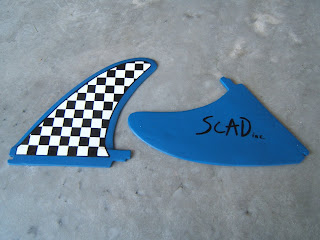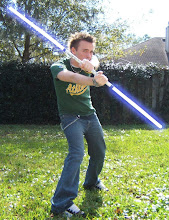



Mouse on the left, belt sander on the right...
 Nice curves, huh? it gets better.
Nice curves, huh? it gets better.
 I then covered pretty much the entire outside curves with bondo. I recommend if any of you use bondo to only mix up a little at a time and do it in segments. The stuff dries up wicked quick. I used a putty knife to smooth it down, to ease the sanding process later.
I then covered pretty much the entire outside curves with bondo. I recommend if any of you use bondo to only mix up a little at a time and do it in segments. The stuff dries up wicked quick. I used a putty knife to smooth it down, to ease the sanding process later.
 I then spent about an entire day sanding the sides smooth. A little with the belt sander, but mostly the mouse. The belt sander eats up the bondo even faster than the mdf. I came out of the process looking like I had just killed frosty the snowman. Seriously, that stuff got everywhere.
I then spent about an entire day sanding the sides smooth. A little with the belt sander, but mostly the mouse. The belt sander eats up the bondo even faster than the mdf. I came out of the process looking like I had just killed frosty the snowman. Seriously, that stuff got everywhere.


I also cut out a back plate and started sanding it down smooth. The curves on the edges of the back plate are going to be much larger than the top. I've also decided to either go with legs screwed onto the backplate, a temporary box-like support, or no support at all and set it on my audomin for now, which will most likely happen until I figure out how to permanently support it. Any suggestions? I won't put any support on it until its 100% finished anywhays. I would like to avoid making a chest out of it like Kyle did on his NES controller simply because the curves on the side would make the chest too small, though it works beautifully for the NES controller. I'm thinking about going with the 4 simple table legs so it looks like a coffee table while still maintaining that controller look. It would also make it look nice if I end up going with the glass top look.

I'd say 40 inches wide is about the right size... its scaled up by 7.2 times the size of the original controller.
 I actually CAD'ed the entire controller with the help of Andre and took it up to office max to print it up full size (I'll post a picture of the CAD drawing when I get a chance). I then traced the outline and details, then cut it out with my jigsaw.
I actually CAD'ed the entire controller with the help of Andre and took it up to office max to print it up full size (I'll post a picture of the CAD drawing when I get a chance). I then traced the outline and details, then cut it out with my jigsaw.












 .... ya.
.... ya. And now on the board.
And now on the board.






















